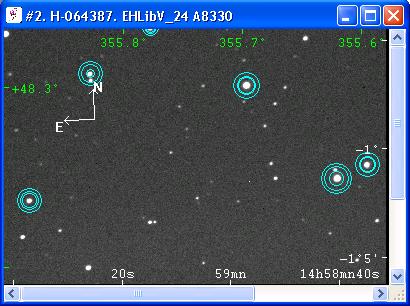Image photometry. Intruder and variable
detection
The program precisely measures the intensities of
stars on the image and, by matching them with a catalog that holds
reference magnitudes, photometrically calibrates the image. The magnitude of any
object on the image can then be computed.
The user can select one comparison star, or several of them
for ensemble photometry. Such comparison stars are saved into the database, ready to be reused
on any subsequent image.
There are 2 methods for the photometry: the PSF photometry allows the quick analysis of
an image. The aperture photometry is for very precise magnitude measurements.
An aperture is made of an inner circle for the object to be measured
and of an outer ring for the background; the apertures are also saved
into the database, ready to be reused.
With
an asteroid, the aperture may have orbital elements and then move
with the object.

An image with apertures for the photometry.
A star on the image whose magnitude does not match
the magnitude in a catalog is considered as a variable
and is automatically outlined with a special symbol.
The objects on the image that are not in catalogs
are considered as intruders and may be outlined with a special symbol.
This feature may be especially useful with very large catalogs to detect asteroids, etc.

Detection of an outburst from TY PsA (Sep 17, 2004):
the yellow square is for the comparison star, the blue ticks
are for the control star, the white triangle was automatically by the program
because TY PsA was measured as significantly brighter than in the GCVS catalog.
The variables and intruders can be robotically detected
and saved to the database. The user may then select only the images that give alerts.
A selected object may be monitored and when its magnitude differs from
the one previously recorded, the user is automatically alerted.
The algorithms are smart enough not to trigger phony alerts from
obvious cosmics or hot pixels. The threshold for the variable detection may be parametrized,
so as to be sensitive with precision photometric catalogs,
and to be only coarse with other catalogs.
Images may be selected from the database by keywords and by coordinates.
They may then be robotically analyzed to make bulk photometry.
Data
from a selected astronomical object (magnitudes, heliocentric corrections,
geocentric distances,
statistical uncertainties,
air mass, etc.)
may be exported to third party programs
(Microsoft Excel, MathCAD, ...)
for further analysis (light curves, ...). They may also be exported for submission to
organizations such as the MPC, the AAVSO, the CBA, VSNET.
 The ALCDEF format of the MPC
is supported.
The ALCDEF format of the MPC
is supported.
Digital Blink
The reference image is scanned and
the celestial objects that are detected and measured are saved into an astronomical catalog.
The new image is compared with the catalog and the differences
(variable stars, intruders, etc) are outlined with symbols.
Blinking images
Two images of the same sky area can be overlapped
and blinked. This is a classical way to detect supernova, asteroids and
transient phenomena.
The intruders and variables detected on the images
by matching them with catalogs can also be outlined with symbols on the
blinked image.

